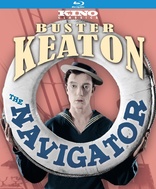The Navigator Blu-ray Movie
HomeThe Navigator Blu-ray Movie 
Kino Lorber | 1924 | 59 min | Unrated | Sep 04, 2012Movie rating
7.5 | / 10 |
Blu-ray rating
| Users | 0.0 | |
| Reviewer | 4.0 | |
| Overall | 4.0 |
Overview
The Navigator (1924)
Two spoiled rich people find themselves trapped on an empty passenger ship.
Starring: Buster Keaton, Kathryn McGuire, Frederick Vroom, Clarence Burton, H.N. ClugstonDirector: Donald Crisp, Buster Keaton
| Comedy | Uncertain |
| Action | Uncertain |
Specifications
Video
Video codec: MPEG-4 AVC
Video resolution: 1080p
Aspect ratio: 1.35:1
Original aspect ratio: 1.33:1
Audio
Music: DTS-HD Master Audio 5.1
Music: LPCM 2.0
Subtitles
None
Discs
25GB Blu-ray Disc
Single disc (1 BD)
Packaging
Slipcover in original pressing
Playback
Region free
Review
Rating summary
| Movie | 4.0 | |
| Video | 4.0 | |
| Audio | 4.5 | |
| Extras | 2.5 | |
| Overall | 4.0 |
The Navigator Blu-ray Movie Review
Buster finds a way to go home, by land or sea or foam.
Reviewed by Casey Broadwater August 22, 2012In 1924, Buster Keaton needed a hit. His last film, Sherlock Jr.—now hailed as a surrealist meta-cinema masterpiece—was a critical bomb, too short at 45 minutes, too cerebral for audiences who just wanted to laugh, and all-around too clever for its own good. One Variety writer, not recognizing Buster's ahead-of-his-time genius, even said it was "about as unfunny as a hospital operating room." Buster and his gag men immediately got busy brainstorming new ideas, but nothing stuck until Keaton's longtime technical director, Fred Gabourie—while scouting boats for a different project—discovered the S.S. Buford, a 500-foot decommissioned military passenger liner that had once served in the Spanish American War and later ferried Russian anarchists and other leftist "undesirables" back to the motherland during the First Red Scare. The ship was set to be scrapped, but Gabourie arranged to lease it for three months, giving it to Keaton as an enormous floating prop to use however he pleased. The result was The Navigator, a slapstick-on-the-high-seas adventure that features some of Keaton's most memorable gags. It would also become his biggest box-office success, ensuring a lucrative three-year contract with producer Joe Schenck, placing Buster in the same league as Charlie Chaplin, and preceding the even larger-scaled vehicular comedy of The General.

"Our story deals with one of those queer tricks that fate often plays," reads the first intertitle, but before we can get to this feat of coincidence, the film introduces a bit of stage-setting political intrigue—spies from one unnamed nation have purchased the steamship The Navigator, and agents from another are intent on setting it adrift during the night unmanned, hoping it'll dash upon the rocks and sink. Of course, neither party expects Buster to be on board. Keaton plays "Rollo Treadway, heir to the Treadway fortune," a variation on his naive layabout rich kid character from The Saphead, which is referenced here when a title card refers to Rollo as "living proof that every family tree must have its sap."
Looking out the window, bored, Rollo spies a pair of newlyweds and makes the spur-of-the-moment decision that he too wants to get married that very day. He has his manservant complete all the necessary arrangements, including booking passage on an ocean liner for a Honolulu honeymoon, but when Rollo proposes to Betsy (Kathryn McGuire), the girl next door, she turns him down with a "Certainly not!" But here's where fate comes in. Through a series of comic miscommunications—and some obscured pier signage—Rollo and Betsy both end up aboard The Navigator right as the spies cut it loose from its mooring. Initially, neither knows the other is there, and Keaton stages a brilliant chase sequence where he and his co-star run up and down the decks, narrowly missing one another at every turn.
When they finally find each other—Keaton falls butt-first through a portal and onto a sawhorse where Betsy is sitting—The Navigator becomes a winning parody of domesticity, with the two rich youngsters, who've never had to do anything for themselves, ineptly trying to make a home on the drifting vessel. Their first challenge is what to do for food, and there's a laugh-out-loud-worthy galley scene where Betsy sets the table with oversized utensils—enormous steak forks and foot-long knives—and makes coffee using seawater and three un-ground beans. Meanwhile, Rollo tries to open a tin of meat with an enormous cleaver and has a mishap with a can of condensed milk.
Given that they're on a passenger vessel, you'd think that lodging wouldn't be an issue, but Rollo gets spooked in his bunk by a swaying portrait of an angry-looking sailor—the ghost-ship vibe is genuinely eerie, with doors that swing open and shut by themselves—and the couple's attempts to sleep on deck are ruined by torrential rain and a close-call where Betsy nearly slides overboard as the camera lists subtly to and fro. They eventually retire to the game room for one of the film's best sight gags, where Buster tries to shuffle and deal a deck of hopelessly soggy playing cards as his girl quietly falls asleep on his shoulder. When an intertitle announces "Weeks later—still drifting," we see that the couple has ingeniously solved all their household woes. Rollo and Betsy now sleep in the ship's twin boilers, down in the hull, and they've rigged Rube Goldberg-esque devices up in the kitchen to streamline food prep.
As usual with Keaton's films, The Navigator builds to a spectacular showpiece climax. In The General it's the train crash, in Steamboat Bill, Jr. the hurricane, and here it's a tribe of cannibal natives intent on having Rollo and Betsy for supper. When the ship runs aground on a hostile island and springs a leak, Buster dons an old-fashioned diving suit and helmet and descends into the depths for the film's most iconic sequence, which was shot in the frigid waters of Lake Tahoe. Rollo cuts a wire with a helpful lobster's claw, sword fights with a sword fish, and when he finally repairs the breach in the hull, he comically "washes" his hands underwater in a simple but hilariously absurd pantomime. I won't spoil the conclusion, but suffice it to say that there's a sudden reversal of fortune that makes for one of the best deus ex machina endings ever.
After the movie-inside-a-dream-inside-a-movie complexity of Sherlock Jr.—go ahead, think of it as the Inception of its time—it's easy to see why audiences flocked to The Navigator, a comparatively breezy comedy with broad, gag-a-minute jokes. It was essentially a big populist blockbuster, albeit one infused with Keaton's thoughtful and sophisticated brand of deadpan slapstick. The Great Stone Face is his typically smile-less self here—pratfalling gracefully, letting his dolorous eyes carry his character's emotions—and Kathryn McGuire makes a great foil, literally keeping pace with Keaton's physical abilities. Their best bit together, though, is sweet and subtle, so subtle, in fact, that you might miss it entirely. Look carefully in the scene where Rollo and Betsy—in their sailor suits—carry candles and peer through the ship's interior; when Betsy leans over to get a better look, you can spy her shadow ever so lightly planting a kiss on the cheek of Buster's shadow. As much as Keaton impresses with his larger-than-life action set pieces, it's the small moments like these that give his films their humanity and warmth.
The Navigator Blu-ray Movie, Video Quality 
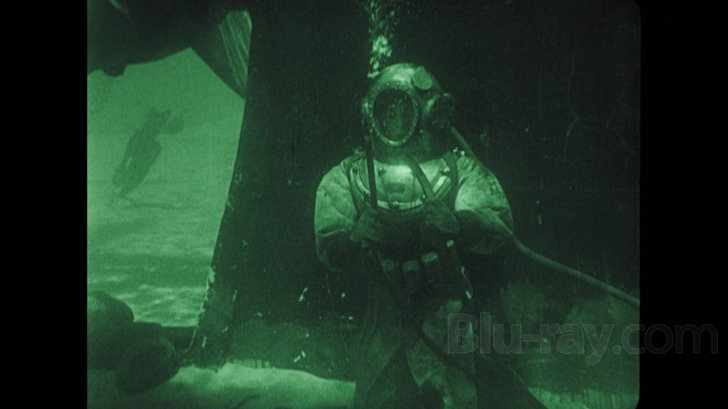
If you've bought Kino's other Buster Keaton Blu-ray releases—and if you haven't, you should—you'll already be familiar with the quality of The Navigator's 1080p/AVC-encoded transfer. Sourced from a 35mm print donated by the Raymond Rohauer Collection, the film is essentially presented as-is, with no significant restoration work. You'll notice white specks and vertical scratches, light staining, slight brightness fluctuations, and the occasional appearance of the sprocket holes encroaching on the 1.35:1 frame, but nothing out of the ordinary for a movie that's now almost 90 years old. I'm often curious what these Keaton films would look like in the hands of, say, The Criterion Collection—with a comprehensive digital restoration —but there's a certain purity to Kino's approach. Each speck and scratch, is, after all, a part of the print's history. Regardless, The Navigator looks better than ever here. Film grain is visible—there's been no DNR smoothing or edge enhancement —and the level of clarity bests previous DVD editions by fathoms, with newly appreciable detail in each frame. The film has been digitally tinted per original specifications—blue at night, green underwater, sepia most of the rest of the time —and the coloring seems natural. The contrast balance is spot-on too, with deep blacks and bright but rarely overblown highlights.
The Navigator Blu-ray Movie, Audio Quality 
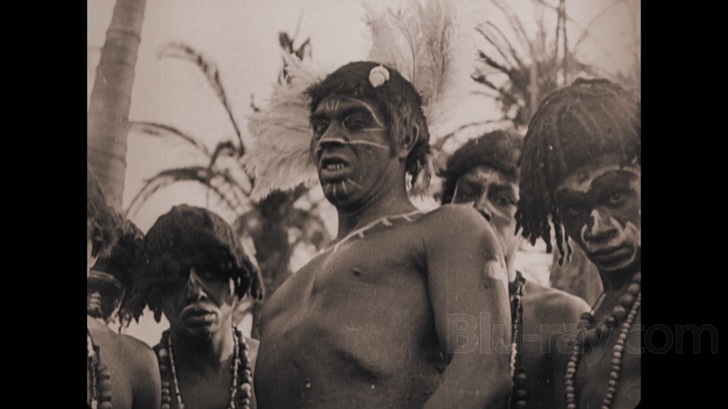
Kino's go-to composer, Robert Israel, has supplied a new score for The Navigator, combining maritime motifs and ragtime-y syncopation. Expect lots of piano riffing, with occasional string and horn accompaniment, sometimes set to the rat-a- tat-tat of martial snare drums. Not too modern, and never overpowering the onscreen action, the music complements the film nicely. The score sounds good too, with clarity and a strong sense of presence when you push the volume a bit. The disc includes both a lossless DTS-HD Master Audio 5.1 surround sound version—in which the music is spread throughout all channels—and a capable uncompressed Linear PCM 2.0 stereo track. Do note that the film's original English intertitles are intact here, but there are no subtitles in any additional languages.
The Navigator Blu-ray Movie, Special Features and Extras 
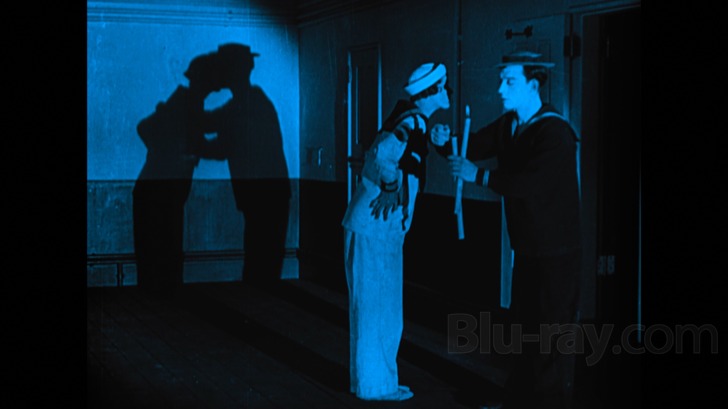
- Audio Commentary: Silent film historians Robert Arkus and Yair Solan team up for an insightful chat that gives a great background of the film's production.
- Featurette (1080p, 8:50): Written by film historian Bruce Lawton, this short documentary is about the making of The Navigator and Keaton's fascination with boats as sources of comedy.
- "Asleep in the Deep" (1080p, 3:15): A recording of the Wildfred Glenn song referenced in the film, set to footage from the film and lyrical text.
- Gallery (1080): A self-guided gallery with sixteen publicity stills.
The Navigator Blu-ray Movie, Overall Score and Recommendation 
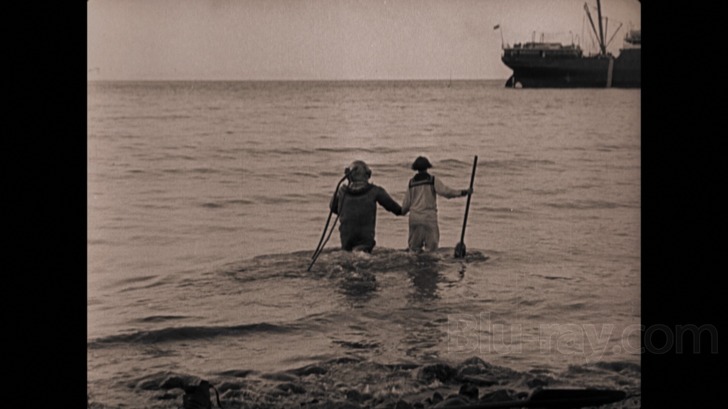
Buster Keaton's biggest commercial success in his own time, The Navigator remains a perpetual fan favorite, a prime example of the vaudevillian legend's comic genius. Really, what's not to love here? Deep sea diving! Cannibals! A spooky ship! Buster sword fighting with a swordfish. For silent film lovers, this is an essential, must-buy release, and Kino has treated it well, with a striking high definition transfer, a great score from Robert Israel, and an informative commentary track. Highly recommended!
Similar titles
Similar titles you might also like

Our Hospitality
Remastered
1923

Lost Keaton
1934-1937

The Saphead
Ultimate Edition
1920

Seven Chances
1925

College
1927

Buster Keaton: The Short Films Collection
One Week / Convict 13 / Neighbors / The Scarecrow / The Haunted House / Hard Luck / The High Sign / The Goat / The Play House [Playhouse] / The Boat / The Paleface / Cops / My Wife's Relations / The Frozen North / The Electric House / Day Dreams [Daydreams] / The Balloonatic / The Love Nest
1920-1923

Steamboat Bill, Jr.
1928

Battling Butler
Cohen Film Collection
1926

Sherlock Jr.
1924

Monkey Business
1931

Buster Keaton: The Shorts Collection 1917-1923
1917-1923

Spite Marriage
included with "The Cameraman" release
1929

Champagne
1928

Three Ages
1923

The Big Mouth
1967

The Admirable Crichton
Limited Edition to 3000
1957

Klondike Annie
1936

Whisky Galore!
1949

The Impostors
1998

The Circus
1969 Rerelease Version
1928
